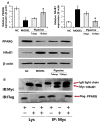Interaction between piperine and genes associated with sciatica and its mechanism based on molecular docking technology and network pharmacology
- PMID: 32130644
- PMCID: PMC7870775
- DOI: 10.1007/s11030-020-10055-9
Interaction between piperine and genes associated with sciatica and its mechanism based on molecular docking technology and network pharmacology
Abstract
Piperine is the main active component of Piper longum L., which is also the main component of anti-sciatica Mongolian medicine Naru Sanwei pill. It has many pharmacological activities such as anti-inflammatory and immune regulation. This paper aims to preliminarily explore the potential mechanism of piperine in the treatment of sciatica through network pharmacology and molecular docking. TCMSP, ETCM database and literature mining were used to collect the active compounds of Piper longum L. Swiss TargetPrediction and SuperPred server were used to find the targets of compounds. At the same time, CTD database was used to collect the targets of sciatica. Then the above targets were compared and analyzed to select the targets of anti-sciatica in Piper longum L. The Go (gene ontology) annotation and KEGG pathway of the targets were enriched and analyzed by Metascape database platform. The molecular docking between the effective components and the targets was verified by Autodock. After that, the sciatica model of rats was established and treated with piperine. The expression level of inflammatory factors and proteins in the serum and tissues of rat sciatic nerve were detected by ELISA and Western blot. HE staining and immunohistochemistry were carried out on the sciatica tissues of rats. The results showed that Piper longum L. can regulate the development of sciatica and affect the expressions of PPARG and NF-kB1 through its active ingredient piperine, and there is endogenous interaction between PPARG and NF-kB1.
Keywords: Molecular docking; NF-kB1; Network pharmacology; PPARG; Piperine; Sciatica.
Conflict of interest statement
The authors declare that they have no conflict of interest.
Figures






Similar articles
-
Piperine treating sciatica through regulating inflammation and MiR-520a/P65 pathway.Chin J Nat Med. 2021 Jun;19(6):412-421. doi: 10.1016/S1875-5364(21)60040-7. Chin J Nat Med. 2021. PMID: 34092292
-
Production of high titre antibody response against Russell's viper venom in mice immunized with ethanolic extract of fruits of Piper longum L. (Piperaceae) and piperine.Phytomedicine. 2014 Jan 15;21(2):159-63. doi: 10.1016/j.phymed.2013.08.017. Epub 2013 Sep 21. Phytomedicine. 2014. PMID: 24060214
-
Anti-snake venom activities of ethanolic extract of fruits of Piper longum L. (Piperaceae) against Russell's viper venom: characterization of piperine as active principle.J Ethnopharmacol. 2013 May 20;147(2):373-82. doi: 10.1016/j.jep.2013.03.022. Epub 2013 Mar 16. J Ethnopharmacol. 2013. PMID: 23506990
-
Piper nigrum and piperine: an update.Phytother Res. 2013 Aug;27(8):1121-30. doi: 10.1002/ptr.4972. Epub 2013 Apr 29. Phytother Res. 2013. PMID: 23625885 Review.
-
Piperine and Its Role in Chronic Diseases.Adv Exp Med Biol. 2016;928:173-184. doi: 10.1007/978-3-319-41334-1_8. Adv Exp Med Biol. 2016. PMID: 27671817 Review.
Cited by
-
Ferula sinkiangensis against gastric cancer: a network pharmacology, molecular docking and cell experiment study.Transl Cancer Res. 2023 Apr 28;12(4):743-764. doi: 10.21037/tcr-22-2292. Transl Cancer Res. 2023. PMID: 37180648 Free PMC article.
-
Based on Network Pharmacology and Molecular Docking, the Active Components, Targets, and Mechanisms of Flemingia philippinensis in Improving Inflammation Were Excavated.Nutrients. 2024 Jun 13;16(12):1850. doi: 10.3390/nu16121850. Nutrients. 2024. PMID: 38931205 Free PMC article.
-
Systems Pharmacology Study of the Anti-Liver Injury Mechanism of Citri Reticulatae Pericarpium.Front Pharmacol. 2021 Apr 12;12:618846. doi: 10.3389/fphar.2021.618846. eCollection 2021. Front Pharmacol. 2021. PMID: 33912040 Free PMC article.
-
Inhibitory Effects of Rabdosia rubescens in Esophageal Squamous Cell Carcinoma: Network Pharmacology and Experimental Validation.Evid Based Complement Alternat Med. 2022 Nov 10;2022:2696347. doi: 10.1155/2022/2696347. eCollection 2022. Evid Based Complement Alternat Med. 2022. PMID: 36408344 Free PMC article.
-
Network pharmacology and in silico approaches to uncover multitargeted mechanism of action of Zingiber zerumbet rhizomes for the treatment of idiopathic pulmonary fibrosis.F1000Res. 2024 Jun 25;13:216. doi: 10.12688/f1000research.142513.2. eCollection 2024. F1000Res. 2024. PMID: 39931327 Free PMC article.
References
-
- Verwoerd AJH, Jan M, Abdelilah EB, Peul WC. A diagnostic study in patients with sciatica establishing the importance of localization of worsening of pain during coughing, sneezing and straining to assess nerve root compression on MRI. Eur Spine J. 2016;25(5):1385–1392. doi: 10.1007/s00586-016-4393-8. - DOI - PubMed
MeSH terms
Substances
Grants and funding
LinkOut - more resources
Full Text Sources
Medical
Miscellaneous

